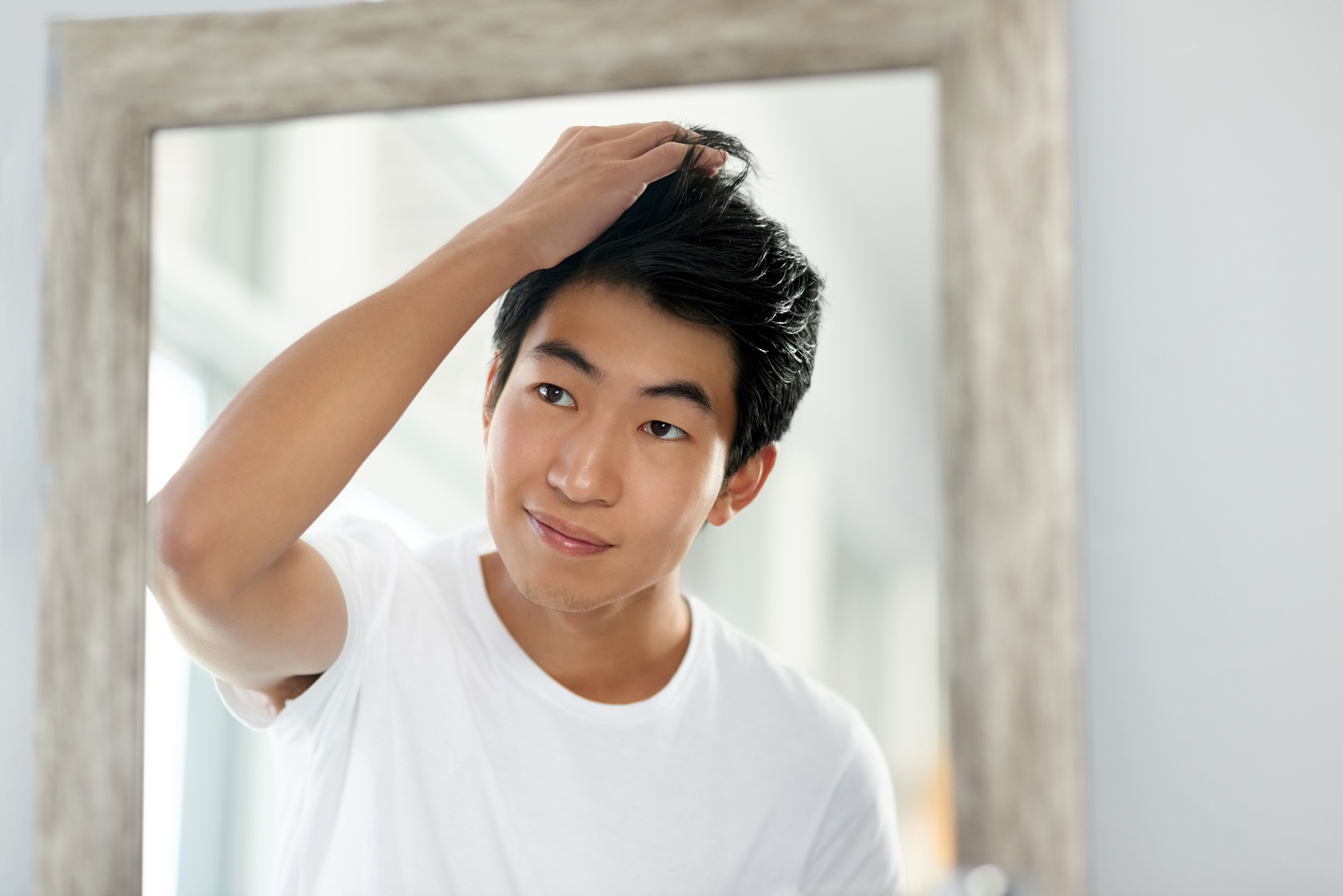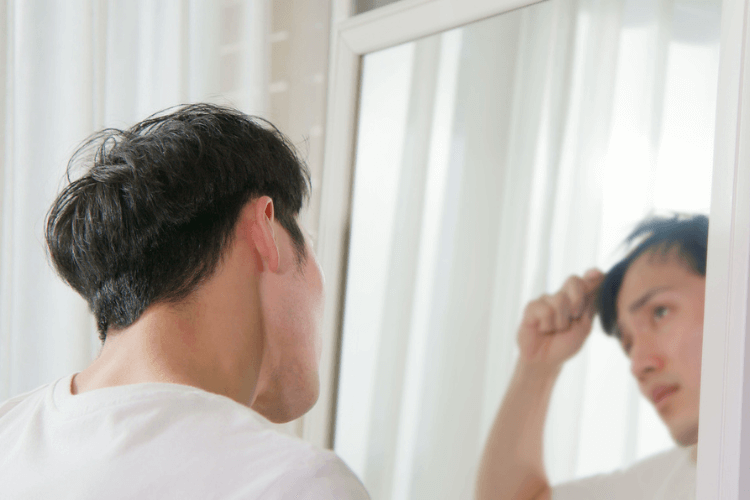Should You Worry About Seasonal Hair Loss?

Seasonal changes come with standard expectations: new weather patterns, new wardrobes, and holidays. What you don’t expect is hair loss. So should you worry about seasonal hair loss? Unfortunately, it can cause confusion and distress. Let’s find out if you’re experiencing seasonal hair loss and how to prevent it.
What is Seasonal Hair Loss?
Losing a bit of hair each day is entirely normal. According to the American Academy of Dermatology Association (AADA), the average person sheds 50 to 100 hairs daily. (01) There’s one time of year, however, when you may find yourself losing more hair than usual. This condition is called seasonal hair loss. With seasonal hair loss, a person loses more than the average amount lost through regular shedding.
Some people may lose up to 150 hairs a day during the fall months, more than the usual amount. Although the reason for this seasonal hair loss is not yet well understood, it’s thought that the condition may be linked to your hair’s growth cycle.
Seasonal Hair Loss and the Hair Growth Cycle
Hair doesn’t stay on your head forever. Instead, hair grows using a cyclical pattern of growth. Every strand goes through distinct phases and eventually falls off your head naturally, after which another new strand grows in its place.
- Anagen Phase: In the anagen phase, hair emerges from the root and undergoes a rapid period of growth. Also known as the “Growth Phase,” hair grows about 6 inches a year for 2 to 8 years in the anagen phase. (02)
- Catagen Phase: Unlike the anagen phase, the catagen phase lasts for a brief 10 days to 6 weeks. During this time, the hair follicle shrinks and starts limiting nutrients to the hair, slowly halting hair growth. (02)
- Telogen Phase: Also known as the “Resting Phase,” the telogen phase lasts about 2 to 3 months. Hair follicles in this phase completely stop delivering nutrients, thus completely stopping hair growth. At the end of the telogen phase is the “exogen phase,” which is when the strand falls out of the follicle, accounting for the 50-100 hairs lost daily. Events that cause stress, however, can result in a condition called telogen effluvium, in which more hair falls out than typically does in the telogen phase. (02, 03)
An analysis published in the British Journal for Preventative Dermatology found that the risk for seasonal hair loss was higher during the summer and autumn months. According to the data, the temperature transition from summer to autumn likely triggers seasonal hair loss.
What Causes Seasonal Hair loss?
The cause of seasonal hair loss has not yet been confirmed. However, most professionals believe that the rapid temperature change between seasons can trigger stress-induced hair loss (telogen effluvium) in some individuals. Telogen effluvium is a diffuse hair loss that happens during times of trauma or severe stress.
Seasonal hair loss is most likely a form of telogen effluvium as a response to temperature and weather changes. Anything from psychological trauma, illness, medication or external factors like temperature can lead to the development of telogen effluvium. Approximately 30 percent of hair follicles transition prematurely into the telogen phase during telogen effluvium, causing more hair shedding than usual.
While temperature changes are thought to be the primary cause of seasonal hair loss, a variety of other factors may also be responsible. For example, the autumn and winter seasons also include the return to the school year and the busy holiday season. The added stress could result in telogen effluvium in the form of seasonal hair loss.
Is Seasonal Hair Loss Permanent?
The good news is that seasonal hair loss is temporary, like most cases of telogen effluvium. However, it may recur with the seasons. Fortunately, there are steps you can take to prevent seasonal hair loss. Here are a few things you can do below:
- Take Care of Your Scalp
- Keep your scalp clean and hydrated, especially during the dry fall and winter months.
- Make sure to massage gently when shampooing. The activity encourages blood flow and keeps follicles healthy.
- Pay Attention to Your Hair
- Keep your hair hydrated during cold or dry weather. Dry weather pulls moisture, so replenish it with a leave-in conditioner or do a deep condition.
- Limit the use of heat styling tools and restrictive hairstyles that pull at your hairline, particularly at times when you notice seasonal hair loss.
- Use shampoos and conditioners that are free of sulfates like our Happy Head Thickening Shampoo & Conditioner.
- Nourish Your Scalp & Hair
- Nutrients help to strengthen your scalp and strands. Consume foods and supplements containing the following: vitamin A, vitamin D, saw palmetto, keratin, and probiotics.
- Shampoos, conditioners, and hair treatments that “thicken” hair are often infused with nourishing ingredients to help grow and strengthen hair.
Keep in mind that seasonal hair loss is temporary and should subside as the months go by. So long as you care for your hair, you should see regrowth in a few weeks to a month. In some cases, however, what you think is seasonal hair loss could be something more serious.
What If It’s Not Seasonal Hair Loss?
A case of seasonal hair loss might be worrisome, but it’s not usually something to lose sleep over. Your hair might be thinner, but you can rest assured that your hair will grow back. What if you have a more permanent condition? How can you tell? To identify the signs of severe hair loss, be on the lookout for: (05)
- Hair that feels lighter.
- Bald patches and a more visible scalp.
- A change or recession in the hairline.
- A more visible scalp.
- An increase in strands found on hairbrushes, bedding, or drains.
- Signs of a bacterial or fungal infection, like itching, burning, or scaly patches.
Seasonal hair loss usually occurs diffusely throughout the scalp, with hair falling in an even fashion. You may be experiencing something other than seasonal hair loss if you experience:
- Patterned Hair Loss: Progressive balding at the top of the head, temple, or hairline is categorized as patterned hair loss. Hereditary conditions like androgenetic alopecia (also known as male pattern baldness) typically see patterned hair loss, like balding at the top of the head. (06)
- Focal Hair Loss: Focal hair loss typically occurs as bare patches on the head, face, or body. This type of hair loss is usually seen in autoimmune conditions like alopecia areata or type 1 diabetes. (06)
Whether your hair loss is temporary (like seasonal hair loss) or “permanent” (like androgenetic alopecia), there are always steps you can take to take control of the situation. Furthermore, the earlier you can identify and treat your hair loss, the better your chances of seeing regrowth.
Treating and Preventing Hair Loss with Happy Head
If you suspect your hair loss is more than seasonal, contact a licensed dermatologist at Happy Head. We can help you determine the cause of your hair loss and develop an individualized treatment plan that’s right for you.
But Happy Head does more than regrow your hair, we help you care for the hair that you have. Our gentle yet effective hair-thickening shampoo and conditioner are infused with hair-strengthening argan oil and biotin. We also offer hair supplements that ensure your scalp and hair get all the nutrients needed to grow healthy and strong. So get started on your hair regrowth journey today with Happy Head here and take our questionnaire.
Resources:
(01) https://www.aad.org/public/diseases/hair-loss/insider/shedding
(02) https://www.ncbi.nlm.nih.gov/books/NBK499948/
(03) https://www.ncbi.nlm.nih.gov/pmc/articles/PMC6709511/
(04) https://academic.oup.com/bjd/article/178/4/978/6602544?login=false
(05) https://www.aad.org/public/diseases/hair-loss/insider/begin
(06) https://jamanetwork.com/journals/jama/fullarticle/2795266




